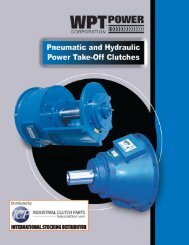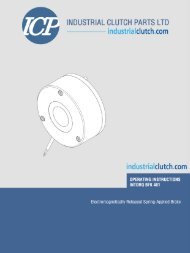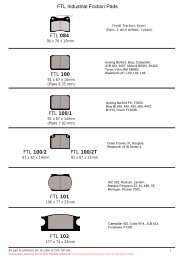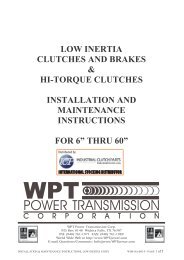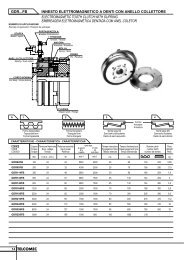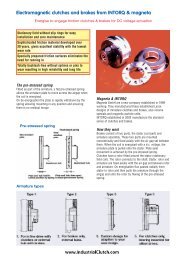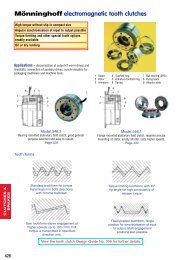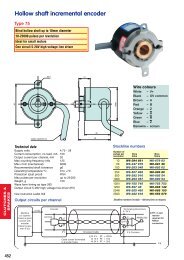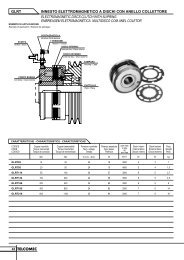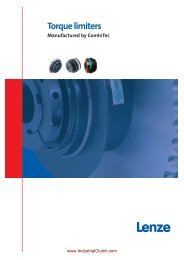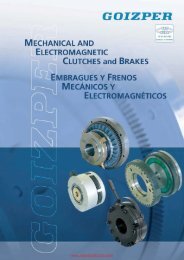FRENI A PINZA CALIPERS BRAKES Positivi & Manuale
FRENI A PINZA CALIPERS BRAKES Positivi & Manuale
FRENI A PINZA CALIPERS BRAKES Positivi & Manuale
- No tags were found...
You also want an ePaper? Increase the reach of your titles
YUMPU automatically turns print PDFs into web optimized ePapers that Google loves.
<strong>FRENI</strong> A <strong>PINZA</strong><strong>CALIPERS</strong> <strong>BRAKES</strong>MPA<strong>Positivi</strong> & <strong>Manuale</strong>Air applied & Mechanically actuatedGENERALITA'INSTALLAZIONEMANUTENZIONEVERIFICHE PERIODICHERICAMBIGENERAL INFORMATIONINSTALLATIONMAINTENANCE AND CAREPERIODIC INSPECTIONSPARE PARTS
INDICEGENERALITA’ pag. 4INSTALLAZIONE pag. 6MANUTENZIONE pag. 8VERIFICHE PERIODICHE pag. 11RICAMBI pag. 11DISEGNO: MPA-MAN ( 8 mm - 12,7 mm ) pag. 20 - 21DISEGNO: MPA ( 8 mm - 12,7 mm ) pag. 22 - 23DISEGNO: MPA-05 ( 8 mm - 12,7 mm ) pag. 24 - 25DISEGNO: MPA-1 ( 8 mm - 12,7 mm ) pag. 26 - 27CONTENTSGENERAL INFORMATION page 12INSTALLATION page 14MAINTENANCE AND CARE page 16PERIODIC INSPECTION page 19SPARE PARTS page 19MPA-MAN ( 8 mm - 12,7 mm ) DRAWING: page 20 - 21MPA ( 8 mm - 12,7 mm ) DRAWING: page 22 - 23MPA-05 ( 8 mm - 12,7 mm ) DRAWING: page 24 - 25MPA-1 ( 8 mm - 12,7 mm ) DRAWING: page 26 - 273
GENERALITA'Corretto utilizzo del prodottoIn ottemperanza al DPR 224/88 DIRETTIVA CEE N. 85/374 definiamo i limiti diimpiego per il perfetto utilizzo del nostro prodotto garantendo la salvaguardiadegli aspetti di sicurezza.Caratteristiche di progettoI freni a pinza della COREMO OCMEA sono stati progettati per operare inconformità delle prestazioni e condizioni previste dal catalogo e dalle relativespecifiche tecniche. E’ fatta in ogni caso raccomandazione perché tali limiti nonvengano superati.Selezione di applicazionePremessa di fondamentale importanza è una corretta selezione dell’unita daimpiegare perché tali limiti vengano osservati e rispettati.L’Ufficio tecnico della COREMO OCMEA è a disposizione per informazioni,suggerimenti e collaborazioni per una corretta applicazione ed impiego.ImpiegoIl rispetto delle Istruzioni di Montaggio e Manutenzione oltre ad evitare costosesoste improduttive previene incidenti dovuti alla non completa conoscenza delprodotto.Precauzioni al montaggio ed alla manutenzioneAgli addetti a tale funzione si consiglia l’impiego di equipaggiamenti idonei,guanti, occhiali od altro per la protezione adeguata da carichi e/o pesi.Parti rotantiI freni a pinza sono prevalentemente abbinati a parti rotanti. In questo caso leparti in movimento devono essere protette in conformità a quanto prescritto dalleDirettive 89/398/CEE, 93/44/CEE e 93/68/CEE o dalle equivalenti norme vigentinei Paesi in cui vengono utilizzati.4
Materiali di attritoTutti i freni a pinza della COREMO OCMEA sono equipaggiati con materiale diattrito assolutamente esente da amianto e nel pieno rispetto delle Normative eLeggi in vigore per la tutela della salute ed il rispetto dell’ambiente.Oli, grassi, componenti lubrificantiVengono impiegati in quantità estremamente limitate. Per eventuali allergie aqueste sostanze si consiglia l’utilizzo di guanti o creme protettive da asportarecon accurato lavaggio delle mani prima di ingerire cibi o bevande.ImmagazzinamentoNell’immagazzinamento dei freni a pinza si deve tenere conto di una consistenteconcentrazione di peso in poco spazio. Si consiglia un equipaggiamento idoneoagli addetti tale funzione (scarpe di sicurezza, caschi, guanti, ecc) al fine diprevenire il rischio di incidenti.SmaltimentoLe pastiglie di attrito usurate e gli altri materiali di cui i freni sono composti sonoclassificati come prodotti NON Tossico-Nocivi, pertanto devono essere smaltiti inconformità e nel rispetto delle leggi vigenti nei Paesi in cui vengono utilizzati.StoccaggioAlcuni tipi di freni contengono membrane in silicone o in gomma ed in caso diincendio possono generare gas tossici. Agli addetti allo smaltimento, in ambientidi piccole dimensioni, si consiglia l’uso della maschera antigas.5
1.0 INSTALLAZIONE1.1 Montare il freno su di un piano rigido della macchina o su di un supportoadatto a sopportare la forza tangenziale del freno: F = 556 N per il frenoMPA, di F = 1516 N per il freno MPA/05, di F = 3888 N per il frenoMPA/1 e di F = 2880 N per il freno MPA/<strong>Manuale</strong>.1.2 Il freno deve essere montato in posizione orizzontale in modo che ilpeso del pistone non gravi sulle leve. Lo schema qui sotto aiuta a megliocomprendere la posizione consigliata di migliore impiego ( Fig. 1 ).Per posizioni diverse consultare il nostro ufficio tecnico.Figura 1 :1.3 Collegare il pistone di spinta del freno alla linea di alimentazione dell'ariatramite un raccordo da 1/8"gas per il freno MPA ( o 1/4"gas per il frenoMPA/05 e MPA/1 ) ed un tubo flessibile di lunghezza tale da consentireal pistone un'ampia possibilità di movimento.1.4 La pressione di comando non deve essere superiore a 6 bar. L’aria nondeve essere contaminata da olio od acqua. Usare quindi un filtro da 25micron con scarico automatico della condensa.1.5 Fissare il freno sulla base di appoggio con N. 1 vite da M10 classe 8.8,coppia di serraggio : 45 Nm.6
1.6 Regolare i pattini tramite il grano C61726 ruotandolo in modo opportunocon una CH BR 2 mm; i ferodi devono essere paralleli al disco ( Fig. 2 )ed il gioco tra disco e ciascun ferodo deve essere = 1mm.Figura 2 :NOTA: Non azionare il freno senza che il disco sia inserito tra i ferodi. Ilmancato rispetto di questa raccomandazione può comportare ilrischio di schiacciamento delle dita.7
2.0 MANUTENZIONETUTTI I TIPI DI INTERVENTO SUL FRENO DEVONO ESSEREEFFETTUATI A MACCHINA FERMA2.1 SOSTITUZIONE DELLE PASTIGLIE DI FERODO2.1.1 Togliere i seeger C62145 fissati sul perno di snodo del pattino.2.1.2 Sfilare il perno C62140.2.1.3 Togliere il ferodo usurato e sostituirlo con uno nuovo e rimontarloprocedendo in senso inverso ai punti 2.1.2 e 2.1.1 .NOTA: Le pastiglie di attrito usurate e gli altri materiali di cui i freni sonocomposti sono classificati come prodotti NON Tossico–Nocivi,pertanto devono essere smaltiti in conformità e nel rispetto delleleggi vigenti nei Paesi in cui vengono utilizzati.2.2 PULITURA DELLE SUPERFICI DI ATTRITOProcedere allo smontaggio dei ferodi, come descritto al punto 2.1.2.2.1 Rimuovere eventuali presenze di olio o grasso dalla superficie del discousando un prodotto detergente e non inquinante.NOTA: Per eventuali allergie a queste sostanze si utilizza l’utilizzo diguanti o creme protettive da asportare con accurato lavaggiodelle mani prima di ingerire cibi o bevande.2.2.2 Se i ferodi risultassero contaminati solo superficialmente è beneprovvedere alla loro pulitura con tela smeriglio a grana fine. In caso dicontaminazione profonda dei ferodi è bene provvedere alla lorosostituzione come descritto al punto 2.1.NOTA: Tutti i freni della COREMO OCMEA sono equipaggiati conmateriale di attrito assolutamente esente da amianto e nelpieno rispetto delle Normative e leggi in vigore per la tuteladella salute ed il rispetto dell’ambiente. E’ comunque buonacosa non inalare la polvere da essi prodotta e lavarsiaccuratamente le mani prima di ingerire cibi o bevande.2.3 SOSTITUZIONE DELLE GUARNIZIONI DI TENUTA EMEMBRANA2.3.1 Togliere la pressione dal pistone e scollegare il tubo flessibile.8
FRENO MPA2.3.2 Smontare il freno dalla macchina.2.3.3 Togliere la molla C62142.2.3.4 Svitare le viti C61534 e i dadi C61613, allargare le leve e sfilare ilpistone K90187 ( K90188 per disco spessore 12,7 mm ).2.3.5 Infilare un cacciavite nel foro da 1/8"gas dell'alimentazione e spingerefino a provocare la completa fuoriuscita del pistone interno C61896(C61898 per disco spessore 12,7mm) dal corpo cilindrico C61897(C61899 per disco spessore 12,7 mm).2.3.6 Togliere la guarnizione di tenuta C61676 e sostituirla con una nuova,dopo averla ingrassata leggermente con un grasso minerale ed infilare ilpistone C61896 ( C61898 per disco spessore 12,7 mm ) nel corpocilindrico C61897 ( C61899 per disco spessore 12,7 mm ).2.3.7 Rimontare il pistone e il freno sulla macchina; ricollegare il tubo flessibileed alimentare il pistone con pressione max 6 bar.2.3.8 Azionare più volte il freno per constatare il perfetto scorrimento delpistone interno e/o eventuali perdite d’aria.FRENO MPA-052.3.9 Svitare le ghiere C61133 e togliere il pistone dal freno.2.3.10 Togliere le viti C61371, il coperchio D70865 e sfilare il pistone internoZ50007.2.3.11 Togliere la guarnizione di tenuta C61139 e sostituirla con una nuova.Dopo aver ingrassata leggermente la guarnizione con grasso mineralerimontare operando in senso inverso ai punti : 2.3.10, 2.3.9, 2.3.1.FRENO MPA-12.3.12 Svitare le ghiere C61133 e togliere il pistone dal freno.2.3.13 Svitare le 8 viti C61198 e dadi C61345, e togliere il coperchio E80710.2.3.14 Togliere la membrana C61518 e sostituirla con una nuova. Rimontareoperando in senso inverso ai punti : 2.3.13, 2.3.12, 2.3.1 .2.4 SOSTITUZIONE DELLA MOLLAFRENO MPA-MANUALE2.4.1 Togliere la manopola D70985 del cannotto filettato C61020 ruotandola insenso antiorario.9
2.4.2 Sostituire la molla C610182.4.3 Riavvitare la manopola D70985 sul cannotto filettato C61020 sino adottenere la coppia desiderata.FRENO MPA-052.4.4 Procedere come descritto nei punti : 2.3.1, 2.3.9. 2.3.10 .2.4.5 Sostituire la molla C60993 e rimontare operando in senso inverso aipunti : 2.3.10, 2.3.9, 2.3.1 .FRENO MPA-12.4.6 Procedere come descritto nei punti : 2.3.1, 2.3.12, 2.3.13 .2.4.7 Rimuovere la membrana C61518, sfilare il pistone interno Z50170.2.4.8 Sostituire la molla C60908 con una nuova. Rimontare il pistoneripercorrendo in senso inverso ai punti : 2.4.7, 2.3.13, 2.3.12, 2.3.1 .2.5 SOSTITUZIONE DELLE MOLLE ALLINEAMENTOPATTINI2.5.1 Togliere la pressione dal pistone e scollegare il tubo flessibile per i freniMPA – MPA/05 – MPA/1.2.5.2 Togliere i seeger C62145, il perno C62140 e rimuovere il pattinoZ50261. Rimuovere la molla C62141 dalla sua sede e sostituirla con unanuova.2.5.3 Rimontare il pattino ripercorrendo in senso contrario dal punto 2.5.2 alpunto 2.5.1.2.6 SOSTITUZIONE DELLA MOLLA DI RICHIAMO LEVE2.6.1 Togliere la pressione dal pistone e scollegare il tubo di alimentazione.2.6.2 Svitare le ghiere C61133 e rimuovere il pistone per i freni MPA/05,MPA/MAN e MPA/1. Svitare le viti C61534 e i dadi C61613, allargare leleve e sfilare il pistone, per i freni MPA.2.6.3 Avvicinare le due leve, rimuovere la molla C62142 e sostituirla con unanuova.2.6.4 Rimontare il freno operando in senso inverso nei punti : 2.6.2, 2.6.1 .10
3.0 VERIFICHE PERIODICHEE’ BENE EFFETTUARE OGNI 3 MESI, A MACCHINA FERMA, LESEGUENTI VERIFICHE DI CONTROLLO. LA PERIODICITA’ DI QUESTEVERIFICHE DIPENDE DALLA FREQUENZA DI USO DEL FRENO.3.1 Verificare il gioco tra ogni pastiglia di ferodo ed il disco di attrito. Quandol’usura dei ferodi raggiunge i 3mm sostituirli.3.2 Verificare che la superficie dei ferodi e del disco siano esenti da grassi, olio sostanze analoghe perché esse impediscono il buon funzionamento delfreno.3.3 Verificare che la vite di fissaggio del freno e delle unità di frenatura siacorrettamente serrata.3.4 Verificare l’integrità dei tubi flessibili.3.5 Azionare ripetutamente il freno per verificare la funzionalità delle molle,della membrana ed il corretto scorrimento dello stelo.4.0 RICAMBI4.1 Per evitare costose soste forzate, consigliamo di tenere in magazzinouna quantità adeguata al numero di freni in servizio, di:Ferodi:cod. N° Z50261Molle pistone: cod. N° C60908 per il freno MPA-1cod. N° C60993 per il freno MPA-05cod. N° C61018 per il freno MPA-MANMolle pattini:Molla richiamo leve:cod. N° C62141cod. N° C62142Membrane: cod. N° C61518 per il pistone 1Anelli di tenuta : cod. N° C61676 per il freno MPAcod. N° C61139 per il freno MPA-054.2 Questi ricambi devono essere conservati in luogo possibilmente buio efresco e lontano da sostanze che possano danneggiare la lorofunzionalità.11
GENERAL INFORMATIONProper use of the productAccording to the EEC norm No. 85/374 the application field boundaries arehereby defined to guarantee a safe and correct use of the product.Design parametersCOREMO OCMEA calliper brakes are designed to operate according to theapplication, performance and environment conditions as specified in the datasheet included into the catalogue.Application selectionA correct model selection is essential to assure that performance limits are notexceeded.The COREMO OCMEA technical department is available for any enquiry.Safe use of productTo prevent accidents and unwanted stops of your production line, the mountingand maintenance instructions must be absolutely respected.Mounting and maintenance precautionsEngineers are advised to wear safety gloves, protective glasses and whatevernecessary to perform a safe installation.Rotating partsThe calliper brakes are mainly linked to rotating and moving parts that must beshielded according to EEC regulations no. 89/398, 93/44 and 93/68 or accordingto the local norms effective in the country of employment.Friction partsCOREMO OCMEA brakes are fully manufactured with asbestos free materialsaccording to the safety and health regulations and in full respect of theenvironment.12
Oil, grease and lubricating componentsThe lubricating materials are employed in very low quantity on our products.Anyway the use of gloves or protective creams to prevent skin allergies is highlyrecommended. Remember to carefully wash your hands before handle any foodor beverages.StorageTo prevent accidents during lifting and storage operations, all the safetyprecautions must be observed. To wear helmets, safety gloves and shoes ishighly recommended. Considering the heaviness of materials, insure to use aproper lift machine during lift operations.DisplacingAll our products are manufactured with non-toxic/harmful materials. Therefore thedisplacement must be performed according with the industrial rules and localregulation of the country of employment.Case of fireSome type of brakes may contain silicon or rubber diaphragm that may generatetoxic gasses in case of fire. Fire fighters are advised to wear proper gas masksduring extinguishing operation.13
1.0 INSTALLATION1.1 Assemble the brake securely on to machine rigid frame or an adeguaterigid base designed to withstand the braking force:MPA brake F = 556 N; MPA/05 brake F = 1516 N; MPA/1 brake F = 3888 N;MPA/MAN brake F = 2880.1.2 The brake should be horizontally mounted to avoid the piston pressingthe brake arms. The following drawing shows the correct position.For further information regarding mounting positions please consult ourtechnical support departement.PICTURE 1:1.3. Connect the air hose to the piston by means of a 1/8"gas threadconnector for MPA brake, and 1/4"gas thread connector for MPA/05 andMPA/1 brakes, ensuring the hose is long enough to allow the brakepiston to move.1.4 The control air pressure should not exceed 6 bar. To ensure the brakefunctions correctly. The air supply should be free from oil or water.Therefore a 25 micron filter should be used, fitted with automaticcondensation discharger.1.5 Fasten brake on the machine by means of one M10, class 8.8 bolts, witha torque of 45 Nm.14
1.6 Using a 2mm allen key, adjust the C61726 inner screw to align the liningpads parallel to the disc, as shown picture 2.PICTURE 2 :CAUTION:Do not perform braking if the disc is not correctly placedbetween the lining pads. It's otherwise possible toaccidentally hurt your fingers if this caution is notrespected.15
2.0 MAINTENANCE AND CAREALL MAINTENANCE OPERATIONS MUST BE PERFORMED ONLYWHEN THE MACHINE IS STOPPED.2.2 LINING PADS REPLACEMENT2.2.1 Take off the snap-ring C62145 mounted on the pin C62140.2.2.2 Remove the pin C62140.2.2.3 Replace the worn lining with a new one and reassemble the pin C62140and the snap ring C62145.NOTE: The friction pads used in this product are asbestos free andnon-toxic/harmful materials, and they have to be displacedaccording to your local regulation.2.2 FRICTION SURFACE CLEANINGRemove lining pads as already explained at the point 2.1.2.2.1 Use a non-polluting cleansing product to remove oil and grease tracesfrom the disc surface.NOTE: To avoid skin allergies use of gloves or protective creams.Remember to carefully wash your hands before handle anyfood or beverage.2.2.2 In case of shallow contamination of linings by any lubricant agent, thesurface may be cleaned wrapping it with an medium abrasive emerysheet. In case of deep contamination the full replacement of linings issuggested.NOTE: According to the European health and environment regulationall COREMO OCMEA products are asbestos free, and onlynon-toxic materials are used. Anyway the inhalation ofproduced exhausted dust should be absolutely avoided.2.3 GASKET AND DIAPHRAGM REPLACEMENT2.3.1 Off the air supply and disconnect the tubing.MPA BRAKE2.3.2 Remove the brake to the machine.16
2.3.3 Remove the spring C62142.2.3.4 Remove the screws C61534 and take off the piston K90187 ( K90188 fordisc sp. 12,7 mm ).2.3.5 Remove the internal piston C61896 ( C61898 for disc sp. 12,7 mm )from piston assy K90187 ( K90188 for disc sp. 12,7 mm ) by pushingwith a screwdriver into the air supply hose 1/8"gas.2.3.6 Replace the seal C61676 with a new one greased with mineral grease.2.3.7 Reassemble the piston assy K90187 ( K90188 for disc sp.12,7mm ) andthe brake.2.3.8 Reconnect the air supply hose and supply the piston with a 6 barmaximum pressure.2.3.9 Operate the brake several times to ensure that there is no air leakageand the piston rod is moving correctly.MPA-05 BRAKE2.3.10 Remove look nut C61133 completely and remove the piston from thebrake.2.3.11 Slacken the piston cover screws C61371 and remove the cover D70865and the internal piston Z50007.2.3.12 Replace the seal C61139 with a new one greased with a mineral grease.2.3.13 Reassemble the internal piston Z50007, the cover D70865 and thescrews C61371.2.3.14 Reassemble the piston assy on to the brake placing the correct numberof shims C61894 and lock the lock nut C61133.2.3.15 Operate the brake few times to ensure the internal piston is workingfreely also to check for any air leeks.MPA-1 BRAKE2.3.16 Remove lock nut C61133 completely and remove the piston from thebrake.2.3.17 Slacken the piston cover screws C61198 and remove the cover E80710.2.3.18 Replace the diaphragm C61518 with a new one. Reassemble the brakefollowing backward from point 2.3.17 up to point 2.3.16 and the point2.3.1.17
2.4 SPRING REPLACEMENTMPA MANUAL BRAKE2.4.1 Pull out the hand knob D70985 from the sleeve C61020 turning itanticlockwise.2.4.2 Replace the spring C61018.2.4.3 Screw the hand knob D70985 on the sleeve C61020 up to get thedesired torque.MPA-05 BRAKE2.4.4 Proceed as shown from point : 2.3.1, 2.3.10 and 2.3.11 .2.4.5 Replace the spring C60993 and reassemble following backward frompoint : 2.3.11, 2.3.10, 2.3.1 .MPA-1 BRAKE2.4.6 Proceed as shown from point : 2.3.1, 2.3.16, 2.3.17 .2.4.7 Remove the diaphragm C61518 and the internal piston Z50170.2.4.8 Replace the spring C60908 with a new one. Reassemble the pistonfollowing backward from point : 2.4.7, 2.3.17, 2.3.16, 2.3.1 .2.5 LINING PADS ALIGNMENT SPRINGS REPLACEMENT2.5.1 Off the air supply and disconnect the tubing.2.5.2 Pull out the snap ring C62145 and remove the pin C62140. Then takeout the socket Z50261. Remove the C62141 spring from its guide andreplace it with a new one.2.5.3 Reassemble the lining following backward the point: 2.5.2, 2.5.1 .2.6 TENSION SPRING REPLACEMENT2.6.1 Off the air supply and disconnect the tubing.2.6.2 Remove the piston from the brake as explained at the point: 2.3.4(MPA), 2.3.10 (MPA-MAN, MPA-05, MPA-1).2.6.3 Replace the spring C61039 with a new one.2.6.4 Reassemble the brake following backward from point 2.6.2 up to point2.6.1 .18
3.0 PERIODIC INSPECTIONSWE RECOMMEND TO PERFORM THE FOLLOWING TESTS EVERYTHREE MONTS.3.1 Check the gap between the lining pads and the disc. Whenever the gapis 3 mm, replaced the linings.3.2 Verify that no lubricant traces are found on the disc or lining surfaces. Incase of contamination follow up the procedure at point 2.23.3 Check out that all locking screws are tighten properly.3.4 Check out integrity of flexible hoses.3.5 Switch on and off the air supply several times, to check up the sealsintegrity, springs functionality, and the proper sliding of push rod.4.0 SPARE PARTS4.1 To avoid unnecessary stops of your production line, a suitable quantityof spare parts should be kept at store, according to the number ofbrakes in use. Here below the suggested parts are reported:Linings:code No. Z50261Thruster springs: code No. C60908 for MPA-1 brakecode No. C60993 for MPA-05 brakecode No. C61018 for MPA-Man. brakeSocket springs: code No. C62141 for all brakesTensioning springs: code No. C62142for all brakesDiaphragm: code No. C61518 for MPA-1 brakeGaskets : code No. C61676 for MPA brakecode No. C61139 for MPA-05 brake4.2 Those spare parts shall be stored in cool and dark place, and far awayfrom any agent that could damage them or reduce their life andefficiency.19
I.T. 020605ISO 9001 - Certificazione N°0238COREMO OCMEA S.r.l. - VIA GALILEI 12 - 20090 ASSAGO (MI) ITALYTEL. 0039.02.4880697 - FAX 0039.02.4881940 - P.O. BOX 8 ASSAGOINTERNET: www.coremo.ocmea.it28



